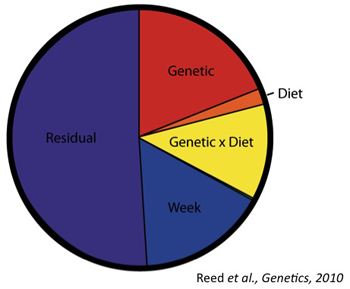
The Reed Lab uses genomic technologies and statistical genetics to assess the relative contribution of diet and genetic variation to metabolic disease in natural populations. The fruit fly is used as a model of Metabolic Syndrome, a condition effecting greater than 30% of (human) Americans. Metabolic Syndrome is typified by obesity and insulin resistance and is a precursor to developing type-2 diabetes and cardiovascular disease. It is the result of a complex interaction between genetics and the transition to a high-calorie/ low-activity lifestyle.
With fruit flies, the Reed Lab is able to independently test the effects of genetic and dietary variation. They have found that, counter to intuition, diet alone makes only a minor contribution to the total variation in metabolic phenotype. Instead, genetics and the interaction between genes and diet are much greater contributors. The Reed lab recently received a NIH-R01 grant to map the genes that are interacting with diet to cause metabolic variation.